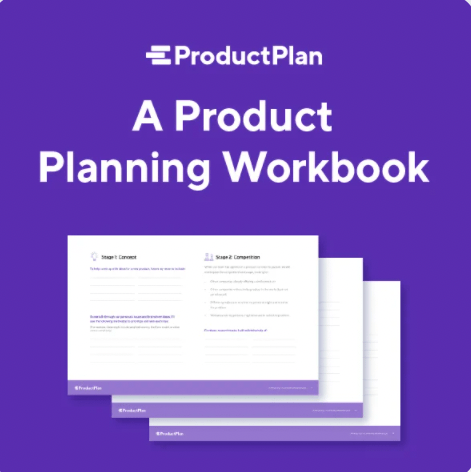What is Product Planning?
Product planning is a complex term to define due to its broadness. It involves so many different aspects of a product manager’s job. It’s probably a much more significant portion of your role as a PM than you might realize.
What is Product Planning?
Product planning involves all of the internally focused decisions, steps, and tasks necessary to develop a successful product. In other words, it involves everything you must do that affects the product itself. By contrast, go-to-market planning involves all external-facing steps to introduce and market your product to the public.
Let’s compare some examples from a product plan and a go-to-market plan to understand better how we see both functions.
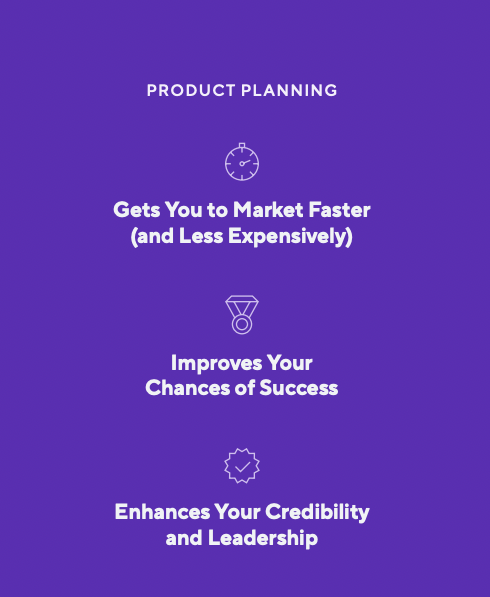
Product Plan:
- What features should we prioritize for the product’s development?
- How will we determine the price points for our product?
- Which vendors will we work with for manufacturing?
- What will be our revenue targets, our goals for new-customer adoption?
- Are there other metrics that we can track to determine the product’s level of success?
Go-to-Market Plan:
- What email campaigns will we develop to inform prospects about our new product?
- Which pieces of marketing collateral should we create for this product launch?
- How and when will we train our sales force on selling the new product?
- Should we develop limited-time promotions to boost early purchases?
- What PR campaigns will we roll out to increase industry awareness before launch?
Product Planning is Not One Meeting or a One-Time Activity
A common misconception among product owners is thinking of “product planning” as just an activity, something they do once in the early stage of a product’s development. They might hold a single meeting with their stakeholders to help decide, for example, what significant themes to prioritize, their target customers, and basic pricing structure. From there, they jump straight into execution mode—never revisiting any of these big-picture strategic decisions.
But the realities on the ground might change. The changes emphasize the importance of not viewing product planning as a one-time step. Product planning remains a significant strategic component of the process itself.
One great thing about incorporating product planning as an ongoing part of your role in creating a new framework. When alterations are needed, this allows you to change your initial planning.
Managing planning changes
Let’s say you acquire new demographic data about your primary user persona. Planning changes when a customer survey reveals new and counterintuitive information about which features to prioritize in your next release. The product team may need to bring in a recent stakeholder with insights your team hasn’t previously considered. All of these scenarios might demand revisiting the decisions you and your team made in your early-stage product planning sessions.
However, changing some of these agreed-upon priorities and decisions midway through your development can feel uncomfortable. That’s why it’s essential to adjust your organization’s mindset, understanding that product planning never actually ends.
So, here’s the bottom line around your product plan. When you approach product planning as a one-time event, the decisions made dictate the entirety of your product’s development. However, it’s strategically advantageous to make decisions throughout the product development process. This allows you to factor in new information and new realities.
Download the Product Planning Process Guide ➜
7 Strategic Phases of the Product Planning Process
While no two products follow the same path, there are some standard stages that nearly all traverse. From the initial spark to the final sunset, here’s what you can expect.
Product Concept Development

Product concept development is the fun part. Coming up with ideas, identifying pain points and problems to be solved, imagining the delight and satisfaction your product can bring. It’s the phase for optimism and possibility.
When there’s enough support for an idea, it’s time to validate it during product discovery, making sure this concept is legit with further exploration and investigation. These learnings and concept reviews help refine the idea.
Competitive Analysis
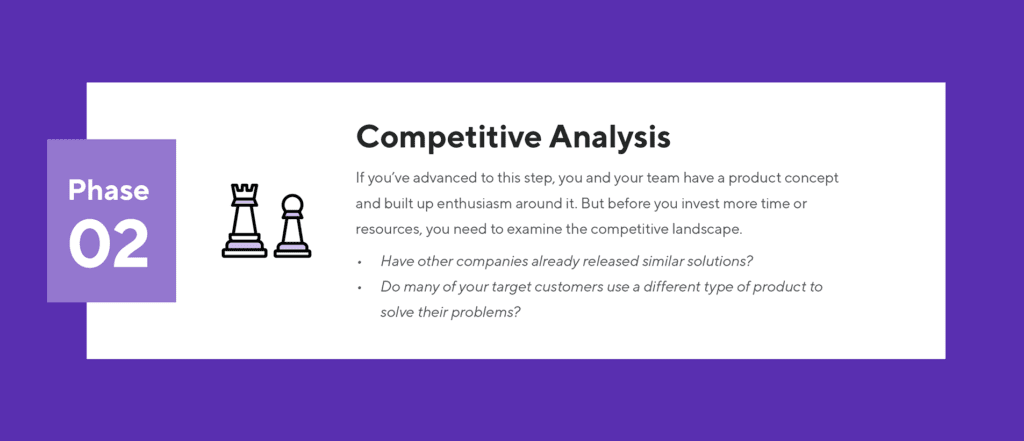
Chances are, you’re not the first one to come up with this fantastic idea, so it’s time to see what else is out there. If you’re late to the game and others are already executing, it’s an opportunity to see where they’re falling short and what parts of the market they’ve already locked up.
The output of this activity reveals whether you’re truly breaking new ground or merely aiming to be a disruptor. With a firm grip on the competitive landscape, you’ll know what you’re up against if you decide to move forward.
Market Research
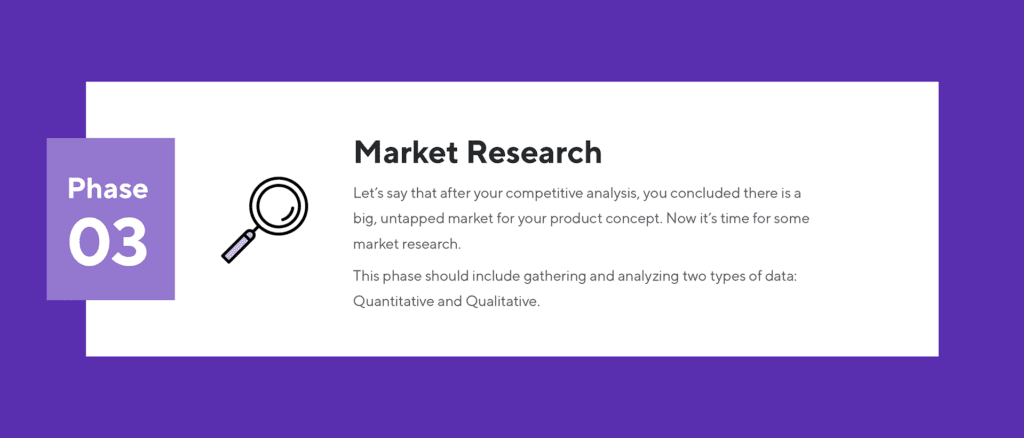
Qualitative and quantitative research helps the business get their arms around the real opportunity. How many people will want your product? How much is a solution worth to them?
By identifying the total addressable market, the team can decide whether they think it’s worth it to invest some technical resources and start making it a reality. You’ll also lay the groundwork for mapping out your go-to-market strategy down the line.
Minimum Viable Product Development
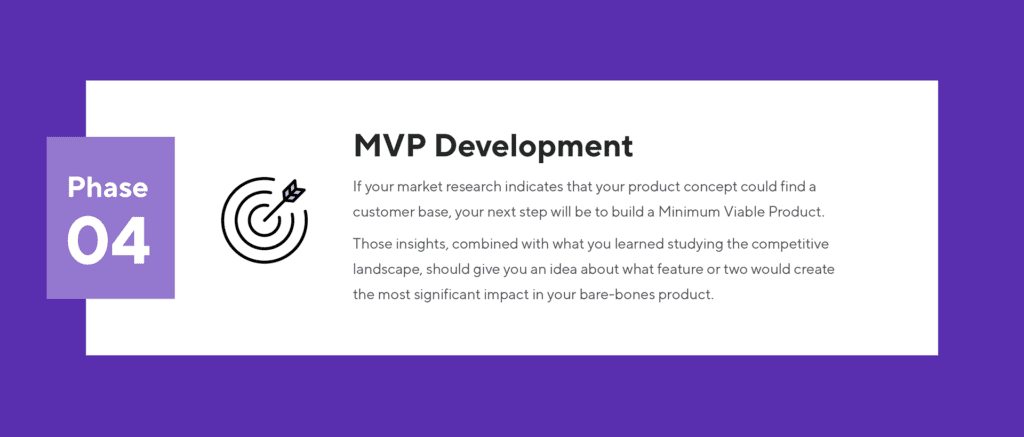
Building an MVP lets you put something in front of prospects that’s more tangible than a slick landing page or slide deck. It’s the best test yet as to whether your concept resonates with users and addresses the pain points and problems that sparked your initial idea.
Coming up with the “minimum” part of the MVP also kicks off the first—of many—times you must prioritize what matters most. Using a framework makes this easier and removes some of the subjectivity for making those calls.
The reaction to your MVP and subsequent iterations of the product set the stage for your initial release.
Product Launch
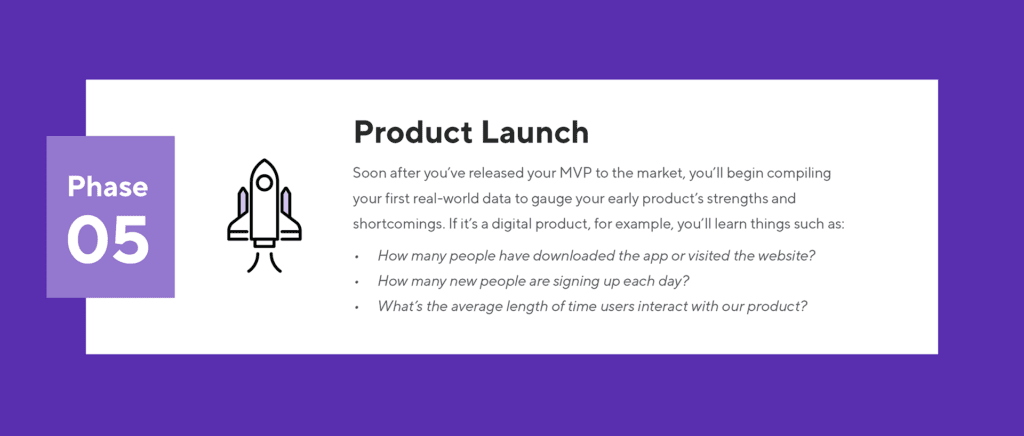
Your big idea has grown into an actual product, and now it’s time to unleash it upon the world with a thoughtful product launch. Product marketing will be fully engaged as they A/B test landing pages, marketing slogans, and price points to maximize the initial buzz of a new release.
When you pull back the curtain, the product positioning and channels to promote the launch are all part of the plan. Meanwhile, the analysts comb through the data and feedback, kicking off another round of learning.
Product Lifecycle Maintenance
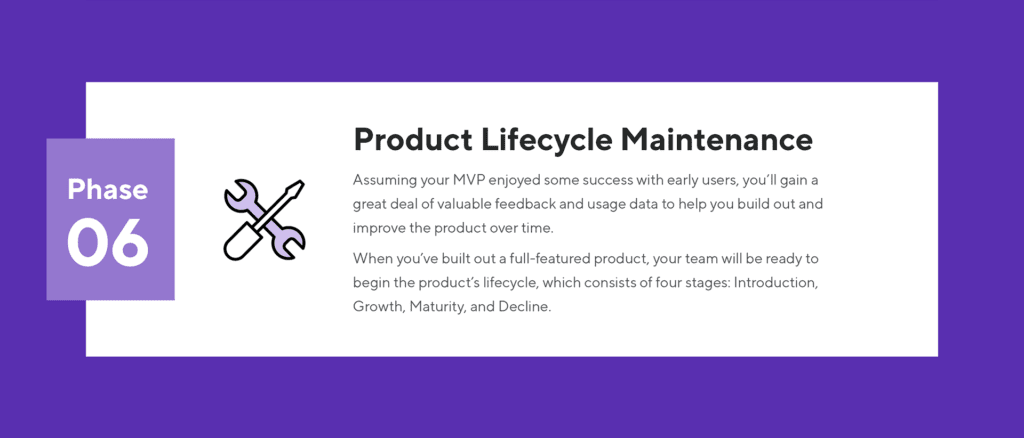
Now a mature product, it’s all about the product roadmap and iterative releases addressing problems. This adds incremental value and expands the market. Planning will focus on themes as the business aims to reach its strategic goals and set new ones once they’re achieved.
The product lifecycle stage spans the product’s rapid growth period. Moreover, the product will hopefully take many years to reach its conclusion. SWOT analysis and similar introspective exercises reveal what must happen to shore things up and chart a course for ongoing success. New functions and target markets may emerge, building on the success of each release.
Product Sunsetting

Most products eventually reach a point of diminishing returns. There’s limited upside in investing additional product development resources or marketing spending as customers move on to the next generation of solutions (or see their original problems fade away).
But this winding down period takes a while; sometimes, the business seeks to maximize the revenue it can extract from its dwindling user base. While this occasionally results in a pivot and newfound life for the product, more often than not, it’s just a slow decline in usage until it’s time to pull the plug finally and transition the remaining user base to something new.
[Free report] 2024 State of Product Management ➜
Infographic

Getting Others Involved in Product Planning
Figuring out the plan for a product sounds like something that people with “product” in their title should handle. Their job is to manage the product, after all. But crafting a plan without including other key colleagues is a recipe for disaster. Let’s think about what can go wrong.
You don’t have all the facts
Product managers know a lot about their products, their target market, and their customers. But they don’t know everything, and acknowledging that from the get-go is a wise approach.
The product development team members know much more about how the product gets built and how difficult or easy additions and changes might be. What seems trivial might be tricky thanks to dependencies or untended technical debt, while projects that seem like enormous undertakings may not require as much work as you’d imagined.
Both sales and marketing have a unique view into how the market receives the product. Moreover, they can identify which prospects and customers have to say. While the product team’s customer research may reveal some, responses to sales pitches and marketing campaigns are also insightful.
Customer support and operations bring their own experiences to the table since they’re more acutely aware of problem areas with the product or related logistics. And, of course, executive-level stakeholders have their priorities and strategic imperatives to satisfy, which may be related to investor concerns or mergers and acquisitions activity above the product team’s pay grade.
You’re creating an uphill battle for building alignment
People involved in the process are inevitably more comfortable with the outcome. Even if they don’t get their way on every issue, their first-hand experience witnessing and participating in the plan’s development means they’ll know the rationale for each decision.
Otherwise, the product team will spend countless hours addressing “what about this?” types of concerns after the fact while trying to generate support and buy-in. Opening product planning up to these individuals avoids this cycle and the related drama.
Product teams can facilitate a transparent, cooperative planning environment by gathering the right team, communicating the expectations for the exercise, and presenting everyone with the same supporting evidence. The process should result in a plan addressing all the burning issues that everyone can get behind.
Being Inclusive Without Surrendering Control
Knowing how important it is to include executives, sales, marketing, operations, support, and product development in product planning, it’s natural to worry about managing all these stakeholders. You want their opinions, input, and buy-in, but ultimately you’re the one who must drive the process and corral all those voices into an intelligent, understandable plan.
Step 1
First, ensure the highest-ranking person in the room doesn’t try to take over. Product should always lead these activities, a neutral party serving as a facilitator. If an executive has concerns, let them air them—ideally in private before the group session begins—reiterate that this is a collaborative process.
Step 2
Next, be sure to state the goals for this exercise upfront. The emphasis here is on making customers happy, so focus on personas and user stories that focus on external users rather than internal wants and needs.
Step 3
Third, actually make the process collaborative. Use prioritization frameworks and other methods that give everyone a turn to vote, score, or otherwise chime in. Give every suggestion a fair hearing, even if you’re ready to dismiss it out of hand, creating an open and welcoming atmosphere.
That said, this doesn’t mean ideas should get a free pass. Press stakeholders for details, context, and a sound rationale. Not just for you, but everyone participating. These arguments should be solid enough to win over the entire room, not just you or the boss.
Finally, be sure to base decisions on reality. That’s why you have product development there! They can usually come up with a quick level of effort and explain why something that seems minor is big (and why something that seems like a massive undertaking isn’t that tough).
Because product managers talk to everyone, they’re the best ringleaders for these activities because they have a holistic view. Offer up that context when needed to explain any tough calls and soothe ruffled egos.
Product Planning for Lone Wolves
Not every organization has a product team. Sometimes it’s just you. But that doesn’t mean you’re on your own to create a product plan all by yourself.
When you’re the only product manager in the place, it’s even more important to involve others in the process. You’re already likely suffering from a case of impostor syndrome, spending chunks of time explaining to coworkers what product management does with no other internal examples to reference.
Your boss is probably in marketing or technology and doesn’t comprehend the full scope of what product planning entails, skimping on the areas outside their comfort zone. And your plate is overloaded with tasks that need delegation.
However, you can turn your unicorn status into a weapon for good by breaking down silos. Since you don’t have a product team to rely on, pull representatives from different teams for planning exercises, welcoming their expertise and perspectives.
This alignment lays the groundwork for slow, deliberate consensus building while also burnishing your internal reputation and credibility. When people see you working closely with different parts of the business and sharing what you’ve learned, they’ll be more confident that your plan represents an amalgamation of internal viewpoints and priorities and not just your particular vision for the future.
Download Strategic Project Alignment in an Agile World ➜
A Good Product Planning Strategy
Product planning is a never-ending part of product management and weaves into everything we do as product managers to develop products successfully. How should the product planning portion of our role look? Whom should we involve, and when? And should we schedule product planning?
Here are a few steps to help you craft your own product planning culture.
1. Create an organizational culture that views product planning as an ongoing process.
This will require a significant shift in thinking for most companies, but it’s worth the effort.
You don’t want to change your core mission every other week, of course. But you also shouldn’t feel beholden to a set of strategic plans from a single meeting held months earlier. Just because you called that your “product planning meeting” and everyone agreed on those decisions back then doesn’t mean the decisions remain final.
When you can persuade your core team, stakeholders, and organization in general that product planning must be ongoing, leaving open the ability to change direction or priorities when the facts demand it, you will ultimately be in a much better position to deliver more successful products.
2. Establish a culture of frequent communication throughout the product development process — not merely in the few meetings you’ve scheduled.
Suppose you encourage your organization to adjust its thinking and understand that product planning might require a shift in priority when the strategic realities call for it. In that case, you will want to communicate more often with your team—and encourage more communication from them as well.
Because your early-stage decisions are more malleable, you might change your plan at various stages throughout the process. Knowing they can suggest changes if they have the data or insights to support them, colleagues might also want to propose updates to your strategic plan. For these reasons, you will want to communicate more frequently across your organization to make sure everyone knows about any updates or additions to your goals.
However, this might take the form of additional, short update meetings. You may also benefit from using a product roadmap tool that automatically alerts relevant teams and individuals when you’ve updated the roadmap.
3. Summarize your research with conclusions and key takeaways — don’t data dump.
Pollsters and other political researchers often use the term “top sheet” when referring to the front page of a technical and usually equation- or graph-heavy report. It’s a handy summary of what’s inside that report. Usually just a few bullets any layperson can understand, such as “42% of respondents said they are concerned or highly concerned about.”
As a product manager suggesting strategic plans or goals for your product or proposing strategic changes as part of ongoing product planning, you’ll want to back up those modifications with data. But that doesn’t mean merely dumping volumes of research onto your team and expecting them to reach those conclusions for themselves.
A good product manager summarizes the data. They present what amounts to a top sheet that clearly and quickly demonstrates support for your ideas. This top sheet might be the data points you’re pulling from a relevant industry report. In other cases, it could be a few key quotes from customers taken from surveys or interviews. The point is to pull out the relevant information from your research. The data can help you make your point without making others sift through the raw data.
However, you will still need to provide that raw data at times. Simply presenting conclusions without the supporting research falls short as well. You must know both.
4. Include product planning ceremonies to make sure everyone on the team is up-to-date and can weigh in.
Following the steps outlined so far avoids one of the most common pitfalls a product manager can fall into: surprising stakeholders with information about the product’s development they had no idea was taking place.
Large ceremonial update meetings can be risky in an environment where the product team doesn’t communicate regularly or share all strategic updates. Some participants may feel blindsided because they’re hearing items under discussion for the first time.
But when you’re treating product planning as a part of the process and informing the team all along the way of any updates and changes, you can introduce product planning ceremonies—meetings, perhaps quarterly—to discuss the product’s current state and any big-picture strategic updates to your plan.
These product planning ceremonies can also be an excellent time for you and your team to discuss any open-loop strategic questions—such as priorities or plans to consider changing that haven’t yet come up for discussion.
The point here is that, because you’ve shifted your company’s way of thinking, discussing a possible tweak to your product plan in a quarterly meeting like this won’t feel like a bombshell that flies in the face of decisions made months ago. It instead will be treated the way it deserves—as an item that, based on new information, evidence or insights, deserves another look as it may lead to a better product—all part of stakeholder management and analysis.
5. Set a reasonable time horizon for your plan
Before Agile became mainstream, it wasn’t unusual to see product roadmaps extending years into the future. There was always a big asterisk that things might change. The further out you looked, organizations had every incentive to set a long-range plan and execute against it.
But iterative development, shorter cycles, and embracing continuous learning make a lengthy time horizon incompatible. That results in reacting to feedback and opportunities. While hardware companies tend to look a year-plus into the future, most software companies are now limiting their roadmaps to an average of nine months out.
Furthermore, this seems to be the sweet spot of having a product strategy and executing against it while not locking in your team to a two-year plan that’s inflexible when situations change. Being adaptable while maintaining consistent goals, objectives, and key results is the ultimate balancing act for product planning.
Download The Product Strategy Playbook ➜
A Product Planning Workbook
Product teams don’t need to reinvent the wheel when it comes to product planning. There are plenty of playbooks and best practices to leverage, streamlining the process while ensuring nothing important gets overlooked.
To help you kick things off, here is a template from ProductPlan. The workbook covers all the bases and can jumpstart your next product planning journey.
